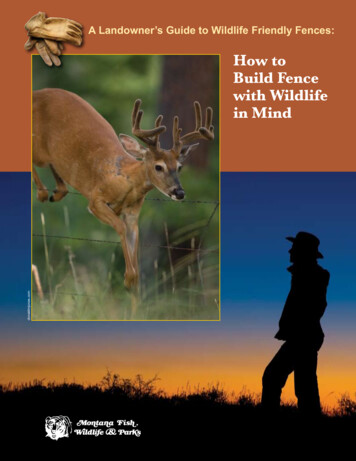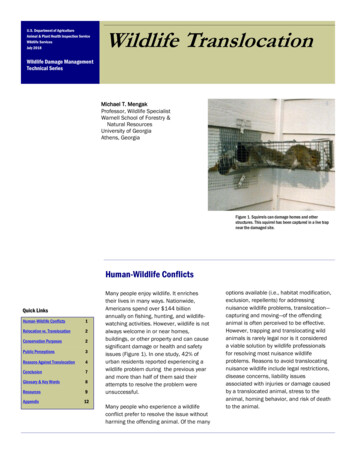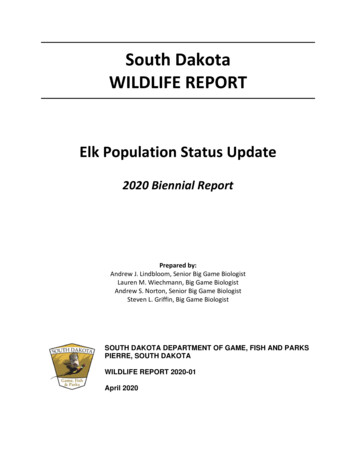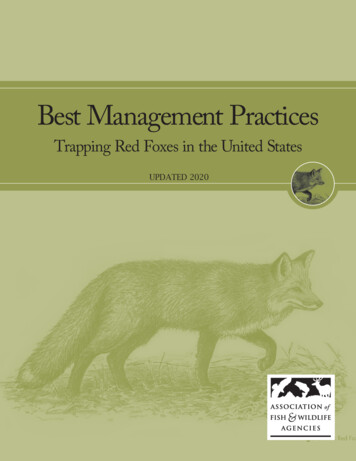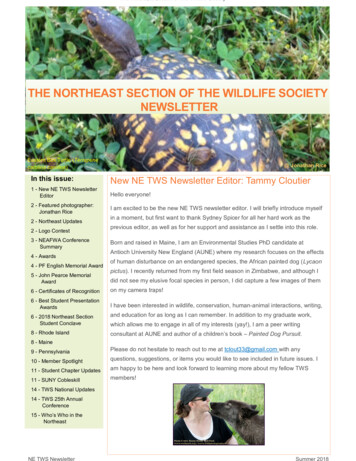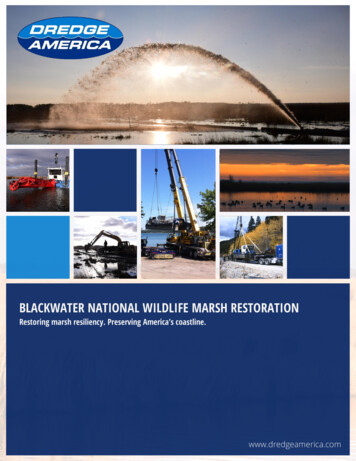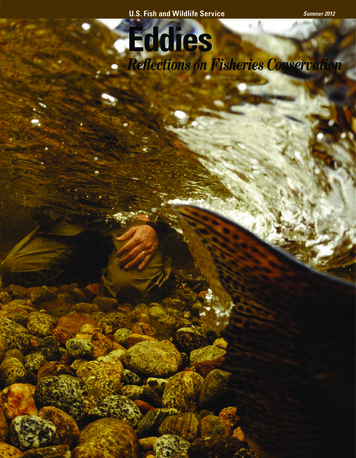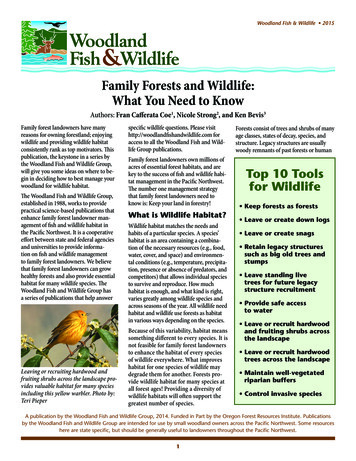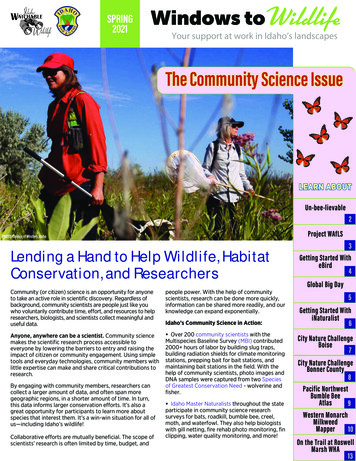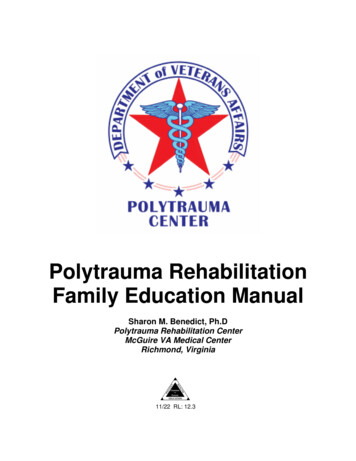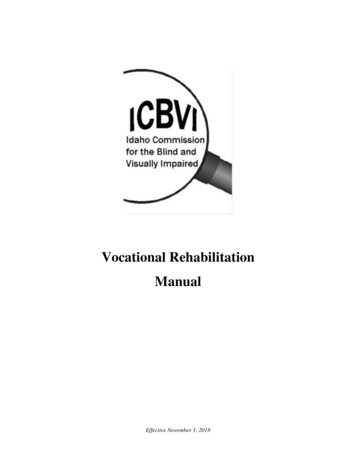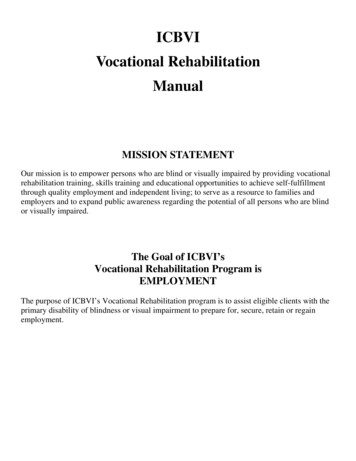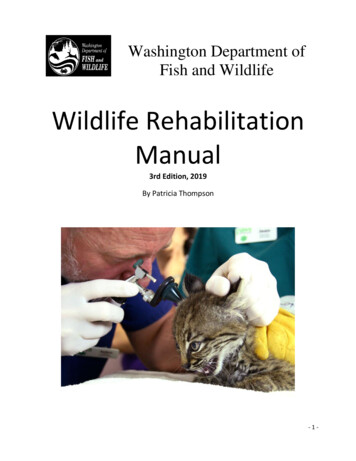
Transcription
Washington Department ofFish and WildlifeWildlife RehabilitationManual3rd Edition, 2019By Patricia Thompson-1-
ACKNOWLEDGMENTSSpecial thanks to Rocky Beach, Washington Department of Fish and Wildlife (WDFW), Wildlife Diversity DivisionManager (retired) who was always supportive of my ideas for improving Washington State Wildlife Rehabilitation.Similarly great appreciation to current Wildlife Assistant Director Eric Gardner for improving the quality and accuracyof the 2014 revision.Also, a special thank you to Dr. Kristin Mansfield, WDFW State Veterinarian for authoritative advice and critique of thisdocument, particularly the veterinary medicine and protocol sections, and for sending fun emails.Several Washington State wildlife rehabilitators provided valuable review for the original Manual adding greatly theutility of this document:Leslie Henry, USFWS; John Huckabee, DVM PAWS Wildlife Center; Margaret Lunnum, Happy Valley Bats; Michael PrattWest Sound Wildlife Shelter; Claudia Supensky, For Heaven’s Sake Animal Rescue and Rehabilitation.Also, thank you to Wildlife Biologists William Moore and Jon Gallie who provided welcome insights for improvingWDFW Wildlife Rehabilitation, and who have talked through many aspects of this profession with me.The new General Wildlife Rehabilitation Exam is a large part of this program and occupies much of this document. Agreat amount of work was put into the exam with several reviewers contributing to the effort. The following personsprovided extensive assessment of the Wildlife Rehabilitation Exam:Jennifer Convy, PAWS Wildlife Center; Leslie Henry, USFWS; John Huckabee, DVM PAWS Wildlife Center; KristinMansfield, DVM, Epidemiologist WDFW.3rd Edition (2019)In 2018 the WDFW formed the Wildlife Rehabilitation Advisory Committee (WRAC) consisting of permitted wildliferehabilitators, members of the public, and WDFW staff. This committee was tasked with advising WDFW on revisingthe wildlife rehabilitation rules (WACs) and encouraged to suggest ideas, edits, and concerns. In 2019 the revisionswere adopted by the Fish and Wildlife Commission. The 3rd Edition of the WDFW Wildlife Rehabilitation Manual is aresult of this 2018-2019 exhaustive rule revision. Members of the WRAC were Crystal Buckley, private citizen; AliciaBye, DVM, West Sound Wildlife Shelter; Hailie Christenson, private citizen; Jennifer Convy, PAWS Wildlife Center;Alysha Evans, Whatcom Humane Society Wildlife Services; Jasmine Fletcher Glaze, A Soft Place to Land; Rachel Rivera,private citizen/Wild Lives Foundation; Jenny Schlieps, Focus Wildlife; Jade Shaw, private citizen/Point DefianceZoo/UW; Kelley Ward, Featherhaven; Suzanne West, Sarvey Wildlife Care Center; Jan White, DVM, Puget SoundWildCare.Thank you to Alysha Evans and Makenna Johansen both of Whatcom Humane Society Wildlife Services, Suzanne Westof Sarvey Wildlife Care Center, and Jenny Schlieps of Focus Wildlife for further review of this document.Cover photo: Dr. John Huckabee examining bobcat kitten. Kevin Mack, PAWS Wildlife Center.-2-
Table of ContentsPageIntroduction4WDFW and Wildlife Rehabilitation5Preparing for Your Life as a Wildlife Rehabilitator5Study Material6Regional Offices & Phone Numbers7Training7-Build a Working Relationship with an Established Permittee7-Your Relationship with a Veterinarian8Species Identification8FIELD GUIDES AND NATURAL HISTORY REFERENCES8-Threatened and Endangered Species9-Common vs Rare Species; Native vs. Non-Native; Nuisance Species9Transferring and Transporting Wildlife10Preparing for the Exam10-Exam Topics11-Washington Wildlife Ecology and Natural History11-Housing and Environment11-Diet, Nutrition and Feeding12-Public Contact and Education12- Restraint and Handling13Animal Stress13Taming, Imprinting, and Habituating14-Disease, Care, and Treatment14-Wildlife First Aid and Triage14-Epizootic Diseases15-Zoonotic Diseases15-Euthanasia & Carcass Disposal16-Release17Release Restrictions18Nonreleasability18-Laws, Rules, and Regulations19APPENDIX 1. Wildlife Rehabilitation Permit Conditions20APPENDIX 2. General Wildlife Rehabilitation Exam Questions21-3-
INTRODUCTIONThank you for your interest in wildlife rehabilitation, a demanding but also very rewarding profession. It is atime consuming and expensive occupation and you could be donating personal time and resources. Onemust be very dedicated and professional to be a successful wildlife rehabilitator. The purpose of wildliferehabilitation is to release physically and psychologically healthy wildlife back to the wild, or relieve theirsuffering through euthanasia. First and foremost, the animals must be considered over personal gain,emotions, or difficulties of the job.All native wild birds, mammals, reptiles, and amphibians are protected by Federal and/or Washington Statelaws and rules (RCWs and WACs). Therefore, wild animals may not be held in captivity without the properpermits. You must be permitted by the state of Washington before practicing wildlife rehabilitation on yourown and comply with all Washington state wildlife rehabilitation rules (WAC 220-450-060 through WAC220-450-200). Permitting ensures high standards of practice in animal welfare and that all persons engagedin wildlife rehabilitation are trained, qualified, and provide humane care and housing for wildlife in theircustody. Individuals must meet several requirements to earn this permit. Those who work with nativemigratory birds must also have a US Fish and Wildlife Service Migratory Bird Rehabilitation Permit. It is thepermittee’s responsibility to comply with all federal laws and regulations as well as state laws.Before making the decision to become a wildlife rehabilitator, ask yourself this most important question:Am I willing and able to provide humane, legal, and proper care while keeping the patient wild at all timesand refrain from allowing my emotions to determine my actions even when it comes to end of life decisions?All wildlife rehabilitators must avoid becoming one who maintains their self-image through wildliferehabilitation and views him- or herself as a "savior,” “friend,” or "trusted companion" of wild animals.Those who pursue wildlife rehabilitation for these reasons, or just to “be around wild animals,” usually domore harm than good. These are wild animals who deserve to be recognized and treated as such. Wildlife inthe care of individuals pursuing wildlife rehabilitation for the wrong reasons often become habituated,tamed, or are captive for too long and have a poor to no chance of surviving in the wild. This style ofrehabilitator also gives the public the wrong impression of normal wildlife behavior and the sometimesdangerous nature of wild animals. They are not pets and never will be nor should be.Wildlife rehabilitation permits require the completion of 1,000 hours of volunteering, working, and/ortraining in wildlife rehabilitation at a permitted wildlife rehabilitation facility. This is equivalent to about sixmonths of full time or two and a half years of one day/week, such as volunteering every Saturday. You willalso be required to list a sponsoring permitted Wildlife Rehabilitator on your permit application, submit atleast one letter of recommendation from a permitted wildlife rehabilitator, and a formal agreement with alicensed veterinarian willing to provide consultation and medical services.After attaining your permit, you must continue your education. Thirty hours of Continuing Education arerequired for permit renewal every three years. Good rehabilitators continue developing their skills nomatter what their level of expertise. State, national, and international professional wildlife rehabilitationorganizations as well as fellow rehabilitators provide opportunities for continued education and increasedskill. Washington Wildlife Rehabilitation Association (WWRA), National Wildlife Rehabilitators Association(NWRA), and International Wildlife Rehabilitation Council (IWRC) publish newsletters and journals, put onconferences, or provide in-person and on-line courses. Joining these organizations is essential forrehabilitators to stay current and connected.WDFW Wildlife Rehabilitation Permits must be renewed every three years. You must complete and submita Permit Renewal Application one month prior to the expiration date and submit all required AnnualReports and Ledgers to qualify for your Wildlife Rehabilitation Permit renewal.A wildlife rehabilitation permit does not authorize a person to be a veterinarian, wildlife biologist, wildlifeofficer, public-health official, or Wildlife Control Operator (someone who, for example, removes raccoons-4-
or squirrels from peoples’ homes). Nevertheless, rehabilitators aid and support all these professions andyou must prepare for a complex role within the professional wildlife community.The following presents an overview of wildlife rehabilitation requirements, and an introduction to theWDFW Wildlife Rehabilitation Exam.WDFW and Wildlife RehabilitationWDFW manages and preserves wildlife at the population level rather than the individual level.Nevertheless, WDFW recognizes the critical role permitted wildlife rehabilitators play in capturing andcaring for sick, injured, and orphaned wildlife in Washington State and acknowledges the value of thisservice to the public, and appreciates the strong network of permitted wildlife rehabilitators with whom tocollaborate. Wildlife rehabilitators assist WDFW by: Ensuring humane and professional care of injured and orphaned wildlife; Providing a network of professional wildlife handlers to assist with wildlife pick-up andemergencies; Providing facilities where WDFW can take injured wildlife; Providing data and staff-power for wildlife research; Assisting in threatened and endangered species recovery; Assisting in disease monitoring, and domestic animal and public health protection; Providing self-regulation and information sharing within the wildlife rehabilitator community; Providing valuable public education.For wildlife rehabilitation in Washington to reach its full potential we must: Establish and maintain compliance with permits and conditions to ensure the best care for theanimals; Establish and maintain compliance with permits and conditions to ensure public safety; Nurture a positive attitude toward fellow wildlife rehabilitators resulting in cooperative networkingand improved services for sick and injured wild animals, and the public; Eliminate over-handling, mal-imprinting, taming, and habituating wildlife at all times; Provide euthanasia for suffering animals in a timely fashion Reduce release of non-native wildlife.The state does not pay for wildlife rehabilitation, nor is it responsible for any costs incurred by a wildliferehabilitator. Nevertheless, WDFW offers Grants to Wildlife Rehabilitators on biennial basis. WildlifeRehabilitators may also want to become a 501(c)(3) tax exempt non-profit organization but it is notrequired.Preparing for Your Wildlife Rehabilitation PermitMaterial in this booklet is designed to give a brief introduction to what you need to know to become awildlife rehabilitator. This booklet does not contain enough information, nor should it be used as yourexclusive resource, for the exam or learning satisfactory wildlife rehabilitation. To be successful, you willneed to read and study materials beyond the scope of this publication. It is equally important that younetwork with licensed Washington wildlife rehabilitators and veterinarians as much as possible and attendwildlife rehabilitation conferences and workshops.-5-
Study MaterialIn addition to the WDFW Wildlife Rehabilitation web pages, must-reads are: The most current editions ofthe NWRA Principles of Wildlife Rehabilitation and NWRA/IWRC Minimum Standards for WildlifeRehabilitation listed below. You will need field guides and basic references recommended to you byrehabilitators to augment your knowledge and understanding. A good source of natural history informationfor a few species is the WDFW Priority Habitats and Species Management Recommendations.Study Guides1. PRINCIPLES OF WILDLIFE REHABILITATION: THE ESSENTIAL GUIDE FOR NOVICE AND EXPERIENCED REHABILITATORS,2ND EDITION. 2002. ADELE MOORE & SALLY JOOSTEN. NATIONAL WILDLIFE REHABILITATION ASSOC. 667 PP.May be purchased at https://www.nwrawildlife.org/store/default.aspx.2. MINIMUM STANDARDS FOR WILDLIFE REHABILITATION 4TH ED. 2012. ERICA A. MILLER DVM, ED. NWRA/IWRC.116PP. (NOTE: A new Edition is being published in 2020 titled STANDARDS IN WILDLIFE REHABILITATION,ERICA A. MILLER DVM, ED., NWRA/IWRC.)May be purchased at rehabilitation 3. COMPENDIUM OF VETERINARY STANDARD PRECAUTIONS FOR ZOONOTIC DISEASE PREVENTION IN VETERINARYPERSONNEL. 2010. NATIONAL ASSOC. OF STATE PUBLIC HEALTH VETERINARIANS, VETERINARY INFECTION CONTROLCOMMITTEE. autions.pdf.4. AVIAN AND MAMMALIAN ZOONOTIC DISEASE qt-science center objects 0#qt-science center objects5. USGS NATIONAL WILDLIFE HEALTH CENTER ications6. SEE ALSO NATIONAL WILDLIFE REHABILITATORS MARKET PLACE FOR BEGINNER TO ADVANCED WILDLIFEREHABILITATION REFERENCES – https://www.nwrawildlife.org/store/default.aspx and INTERNATIONALWILDLIFE REHABILITATION COUNCIL WEBSITE FOR OTHER RESOURCEShttps://theiwrc.org/.THE FOLLOWING ARE FROM DIFFERENT STATES; their laws, regulations, and State Threatened,Endangered, and Sensitive Wildlife Lists WILL NOT APPLY TO WASHINGTON, but theinformation on wildlife medicine, diseases, housing, husbandry, etc. will.7. STUDY GUIDE FOR PROSPECTIVE MAINE WILDLIFE REHABILITATORS & EXAMINATION BOOKLET FOR PROSPECTIVEMAINE WILDLIFE REHABILITATORSMay be downloaded from https://www.maine.gov/IFW/wildlife/pdfs/st
Jennifer Convy, PAWS Wildlife Center; Leslie Henry, USFWS; John Huckabee, DVM PAWS Wildlife Center; Kristin Mansfield, DVM, Epidemiologist WDFW. 3rd Edition (2019) In 2018 the WDFW formed the Wildlife Rehabilitation Advisory Committee (WRAC) consisting of permitted wildlife rehabilitators, members of the public, and WDFW staff. This committee was tasked with advising WDFW on revising
